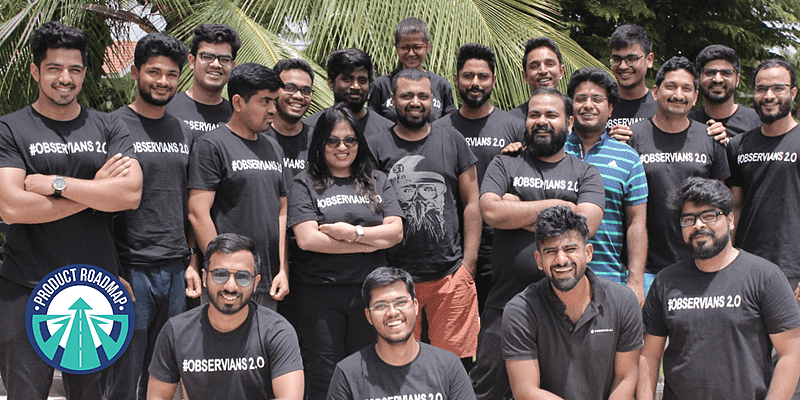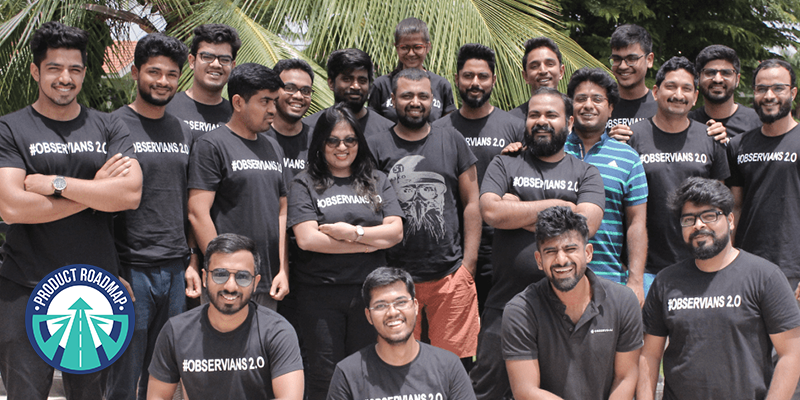[Product Roadmap] From San Francisco to India, how this voice AI startup is changing the call centre experience for all

Sharath Keshava was heading the Southeast Asia region for Practo, working out of Manila, Philippines, the business process outsourcing (BPO) capital of the world. He realised that one of the problems in BPO was delay and latency, which acted as a roadblock in driving faster and better customer experience.
Sharath roped in his friends Akash Singh, who was in InMobi, and Swapnil Jai, who was heading engineering at Twitter, and the trio ended up starting Observe.AI in the San Francisco’s Bay Area in May 2017. The startup launched operations in Bengaluru in 2019.
Observe.AI is a voice AI platform which provides the agent with real-time feedback on customer sentiment and guides them on the next best action during a customer call.

The Observe.AI team
 Also Read[Product Roadmap] Why these founders decided to focus on tech to build real estate startup NoBroker What does the platform do?
Also Read[Product Roadmap] Why these founders decided to focus on tech to build real estate startup NoBroker What does the platform do?
The AI platform listens to the call stream in real time, uses deep learning and natural language processing (NLP) to understand the context and generates suggestions and guidance for the agent. Explaining how the product works, Jitender Vepa, Head of India, and Chief Scientist says,
“Our voice AI technology helps contact centres keep teams productive and empathetic from home so they can provide the best possible customer experience – even while working remotely. To do this we use AI and natural language processing to analyse 100 percent of a support team’s calls for opportunities to improve the customer experience, mitigate compliance/legal risks, and coach agents. Without voice AI, contact centres typically analyse only one percent or fewer calls, and they have a team of quality analysts who do that manually.”How does voice AI help?
Jitender says it can take an hour to review just a single call. They have no real insight into what’s happening on the other 99 percent of calls, or how agents are truly performing.
Teams for quality, compliance, operators, and people managers use multiple platforms and spreadsheets to uncover insights from calls, and to evaluate/coach agents. This process is especially difficult to scale for contact centres who have recently sent all their agents to remote work overnight due to the coronavirus crisis.
With voice AI, these remote teams can work on a 30-minute call in five minutes. They can evaluate 10x more calls and provide agents with more targetted coaching. They can also ensure that they never miss a compliance gap or fraud risk on calls to stay safe. Using one platform helps contact centre teams collaborate and remain connected when they are no longer able to hear and see what’s happening on the call centre floor.
“Currently, we lead the industry in the best speech-to-text transcription accuracy for support calls. We are even more accurate than Google and Amazon, particularly at detecting strong emotions, such as positive or negative sentiment, from calls,” claims Jitender.  Also Read[Product Roadmap] How apartment management app MyGate is tapping tech to ensure security and safety Building the first product
Also Read[Product Roadmap] How apartment management app MyGate is tapping tech to ensure security and safety Building the first product
The first prototype focussed on providing the most accurate transcription of contact centre’s support calls.
The team then continued to enhance features that would detect strong emotions, such as sentiment or tonality, from calls to provide better insights and coaching opportunities. They also built features to detect periods of long silences on calls, which help highlight time management inefficiencies and identify a lack of agent confidence in how to respond to a customer interaction.
“This is called ‘Dead Air’ and drives up the talk time on calls, which can become very expensive for contact centres who need to run at the utmost efficiency to keep costs down for customers,” says Jitender.
One of the early ‘Eureka’ moments for the team was when they visited Manila, Philippines, that houses some of the largest contact centres in the world. When they toured some of these contact centres and showed them the prototype, the executives were blown away, and within two weeks the team had set up more than ten meetings with companies who employ tens of thousands of agents.
“We knew we were on to something and started with tackling the call monitoring and compliance. We then added features to evaluate and coach and will soon offer real-time to complete our offerings for the voice channel before expanding it beyond voice,” says Jitender. Evolution of the product
The team soon realised that building a best-in-class speech recognition engine for support teams was just a means to an end where they could start to help them automate tedious processes and eventually augment agents on live calls.
“At the end of the day, everything we do is geared towards improving the customer experience and the agent experience. The feedback we got from our customers on how to prioritise future advancements for our platform made it clear that real-time agent augmentation would be most valuable to them and something we could uniquely offer, given the higher accuracy of our voice AI platform, which is critical to these future capabilities,” says Jitender.
The team then continued to add new quality management features to their voice AI engine so that contact centre teams could do more with the insights from their calls, including surface the best calls to review, efficiently evaluate and score more calls, provide feedback and coach agents right within Observe.AI in near real-time.
“We continued to improve our ability to auto-suggest the interactions and keywords that contact centres should monitor on their calls to make it easier for them to run their contact centre with efficiency and get meaningful insights from calls,” says Jitender.
The team also started generic integrations as they onboarded more and more customers and realised that there is a need for generic APIs so that they can do integrations faster.
They next focussed on Redaction, which is masking critical/sensitive information to comply with data regulatory guidelines like PCI-DSS, GDPR. The sensitive information includes financial details like card numbers, bank account numbers, and Personally Identifiable Information (PII) such as social security number, addresses, and contact number.
“At Observe.AI, we solved this problem by using named entity extraction of pre-defined entities or categories, which covers both financial and PII information mentioned earlier. First, we identify entities present in a call, such as social security or credit card numbers, and then we redact them from the audio calls and their corresponding transcript,” says Jitender.
 Also Read[Product Roadmap] From breast cancer to river blindness, Niramai is using tech to simplify detection What are they building now?
Also Read[Product Roadmap] From breast cancer to river blindness, Niramai is using tech to simplify detection What are they building now?
Observe.AI is currently building a team dedicated to real-time features that will help teams coach agents on how to personalise the customer experience live on calls and are hiring for multiple product and engineering roles.
This will include features like suggesting a next-best action, alerting a supervisor when an agent might need help, and automating tedious processes, such as data-entry, so that agents can focus on providing a better customer experience on the call.
The team is also adding Spanish language and omni-channel capabilities, such as the ability to evaluate text, email, or chat interactions.
“It’s taken us about a year and a half since we launched our US office to land our first 110 customers and several strategic partnerships. Middle of last year, we started onboarding one of our largest customers and calls coming to our platform increased suddenly by five-fold, which sped up our need to scale our infrastructure. We adopted AWS fargate for some of our services, and introduced data retention in our DBs so that recent data can be accessed fast,” says Jitender.
The global outsourced customer services market is believed to reach $84.7 billion by the end of this year. And yet companies are said to be losing more than $62 billion due to poor customer service.
Some of Observe.AI’s competitors include – Neva.ai and DigitalGenius, among others. Observe.AI follows a standard pricing model for its customers, which is on a per-agent per-month basis.
It also gives out bulk discounts for enterprises that look at large volumes and basis size of the deals. Last year, the team had eight enterprise customers and now has over 100. Some of its clients are – TripAdvisor, Talkdesk, itelBPO, Microsoft, Root Insurance, ClearMe, and ERCBPO to name a few.
Speaking about future plans, Jitender says, “We will increasingly integrate our platform with others, such as CRMs or workforce management platforms to provide updates and alerts, to bring insights from voice calls into those platforms and automate processes.”
(Edited by Javed Gaihlot)
Want to make your startup journey smooth? YS Education brings a comprehensive Funding Course, where you also get a chance to pitch your business plan to top investors. Click here to know more.
Original Source: yourstory.com
Visited 1092 Times, 1 Visit today
